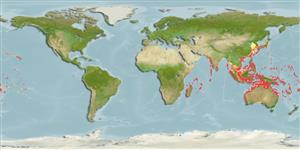Environment: milieu / climate zone / depth range / distribution range
Ecologie
marien; brak water rifbewoner; diepte 1 - 75 m (Ref. 9710). Tropical; 43°N - 32°S, 31°E - 168°W
Indo-Pacific: East Africa eastward through northern Australia extending to Samoa; north to southern Japan.
Grootte / Gewicht / Leeftijd
Maturity: Lm ? range ? - ? cm
Max length : 50.0 cm TL mannelijk / geslacht onbekend; (Ref. 2334)
Dorsale stekels (totaal): 3; Dorsale zachte stralen (totaal): 25-27; Anale stekels 0; Anale zachte stralen: 21 - 27; Wervels: 18. Unique color pattern of large white spots on belly, black spots on yellow background on the back, yellow snout. A white or yellowish band across snout in front of eye. Lips and the area around mouth orange-yellow. A broad vertical white, slightly yellowish band on caudal fin. Scales enlarged above pectoral-fin base and just behind gill opening to form a flexible tympanum. Rows of small anteriorly projecting spines on caudal peduncle. A prominent groove extending anteriorly from front of eye for a distance of about 1 eye diameter. Mouth terminal. Caudal peduncle compressed (Ref 9770). 39-50 rows of plate-like scales.
Lives in clear coastal to outer reef habitats (Ref. 48637). Occurs in clear seaward reefs adjacent to steep drop-offs. A solitary species (Ref. 9710). Uncommon to rare throughout most of its range (Ref. 9770). Adults usually seen along deep drop-offs, swimming about openly and may retreat to caves when approached. Juveniles secretive in small caves with rich invertebrate growth (Ref. 48637). Diet consists of sea urchins, crabs and other crustaceans, mollusks, and tunicates (Ref. 9770). Marketed fresh (Ref. 9770). Among the most highly prized aquarium fishes (Ref. 1602).
Levenscyclus en paargedrag
Maturiteit | Voortplanting | Paaien | Eieren | Fecunditeit | Larven
Distinct pairing (Ref. 205). Spawning occurs in patches of mixed coral rubble and sand on clear seaward reefs (Ref. 37816).
Matsuura, K., 2001. Balistidae. Triggerfishes. p. 3911-3928. In K.E. Carpenter and V. Niem (eds.) FAO species identification guide for fishery purposes. The living marine resources of the Western Central Pacific. Vol. 6. Bony fishes part 4 (Labridae to Latimeriidae), estuarine crocodiles. FAO, Rome. (Ref. 9770)
Status op de Rode Lijst van het IUCN (Ref. 130435)
Gevaar voor de mens
Reports of ciguatera poisoning (Ref. 4690)
Gebruik door de mens
Visserij: van minder commercieel belang; Aquarium: Commercieel
Meer informatie
ReferentiesAquacultuurAquacultuurprofielKweeklijnenGeneticaElectrophoresesErfelijkheidZiektesVerwerkingNutrientsMassaconversie
Tools
Speciale rapporten
Download XML
Internetbronnen
Estimates based on models
Preferred temperature (Ref.
123201): 23.3 - 28.8, mean 27.3 °C (based on 552 cells).
Fylogenetische diversiteitsindex (Ref.
82804): PD
50 = 0.7500 [Uniqueness, from 0.5 = low to 2.0 = high].
Bayesian length-weight: a=0.02570 (0.01232 - 0.05364), b=2.94 (2.77 - 3.11), in cm total length, based on LWR estimates for this (Sub)family-body shape (Ref.
93245).
Trofisch niveau (Ref.
69278): 3.3 ±0.39 se; based on food items.
Weerstandsvermogen (Ref.
120179): Gemiddeld, minimale populatieverdubbelingstijd 1,4-4,4 jaar (Preliminary K or Fecundity.).
Fishing Vulnerability (Ref.
59153): Moderate vulnerability (40 of 100).
Nutrients (Ref.
124155): Calcium = 31 [13, 79] mg/100g; Iron = 0.523 [0.278, 1.149] mg/100g; Protein = 18.6 [16.5, 20.8] %; Omega3 = 0.12 [0.06, 0.23] g/100g; Selenium = 38.9 [19.2, 82.4] μg/100g; VitaminA = 43 [12, 164] μg/100g; Zinc = 1.12 [0.75, 1.68] mg/100g (wet weight);
